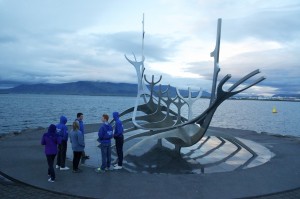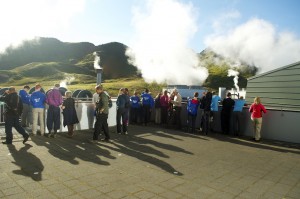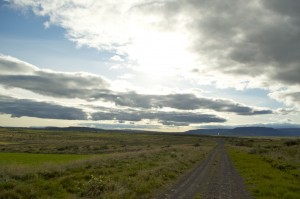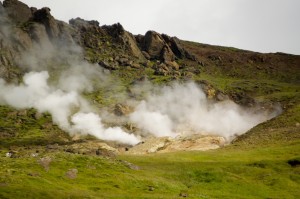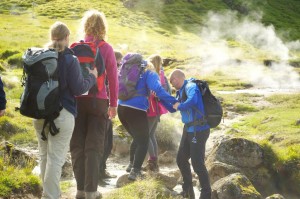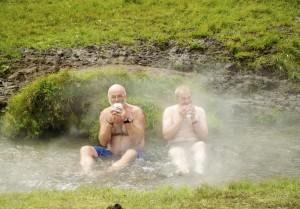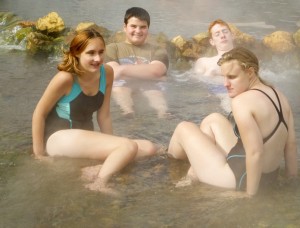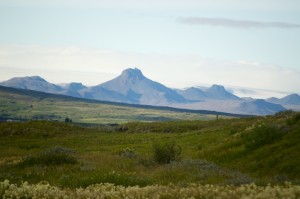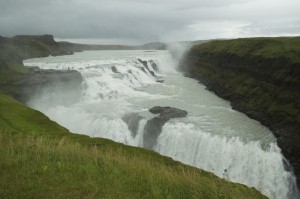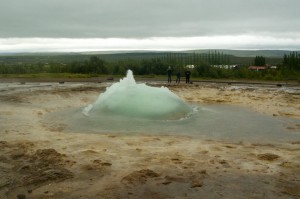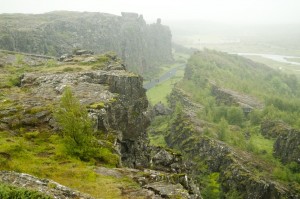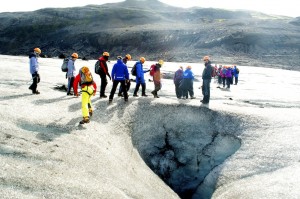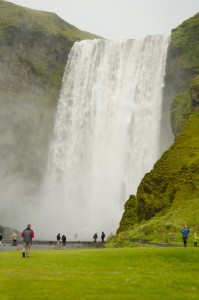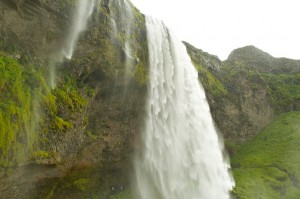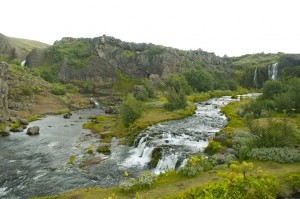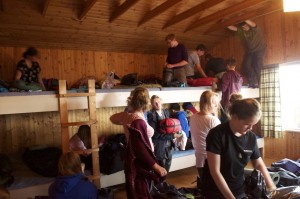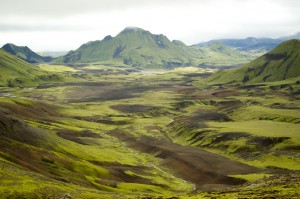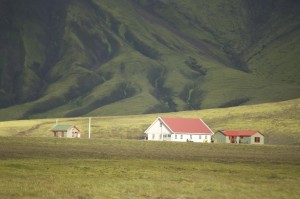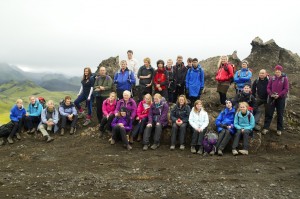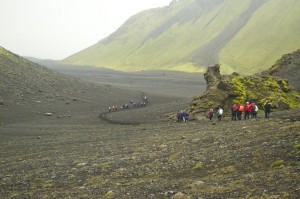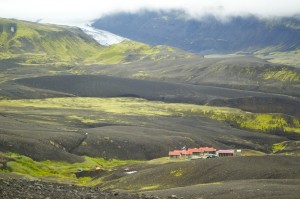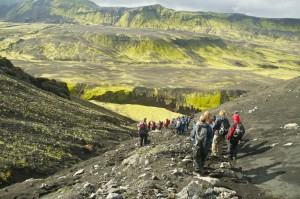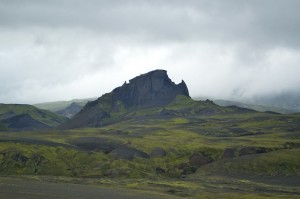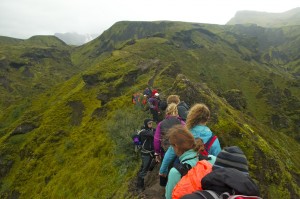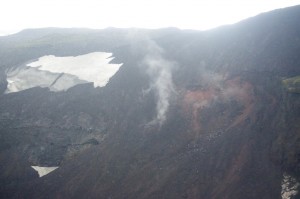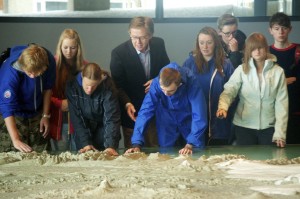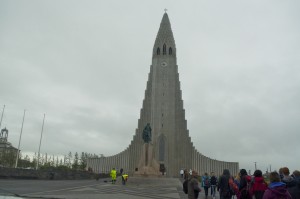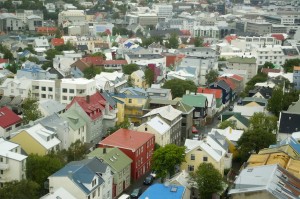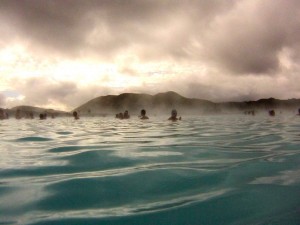The fourth King’s/NCW joint expedition took us to Iceland for a whole range of exciting activities. The NCW students are either blind or visually impaired and the King’s students provide the eyes and the guiding to allow these young people to experience the great outdoors. It is a hugely rewarding experience for all involved. This is the story of our twelve day trip to Iceland.
As we approached Keflavik airport we saw glimpses, through gaps in the cloud, of black coastline fringed with white surf. It looked bleak with little evidence of any human activity. As we walked out of the airport the temperature was hovering around 10 degrees as we were met by our guide, Oskar. Despite the sunshine it was raining lightly.
The landscape between Keflavik and Reykjavik is a volcanic pavement broken by time and weather. Occasional domes of solidified lava cracked and split along the ridge stand out above all else like giant discarded nuts. Scrubland, grass and pathetic shrubs cling to life and the infertile surface. There are no trees in sight until we reach the suburbs or Reykjavik. Volcanically created mountains rise from the coastal plain but their summits are shrouded in heavy, rain laden, clouds. Between these clouds the pale blue sky makes a stark contrast and is reflected in the sea.
Reykjavik is a sprawling capital of largely pre-fabricated, architecturally bland buildings, built primarily for purpose than for looks. In the evening we walk along the sea front to watch it not get quite dark. It is bleak. A cold wind blows in from the sea and I am wearing two fleeces. Cyclists are dressed as we would dress in our coldest winters. Such a contrast to Indonesia and our good summer back home. The sun goes down but it is never very far away from the horizon, preventing true darkness to occur. We walked as far as the sculpture depicting the viking ships which brought the first settlers to Iceland before scurrying back to the warmth of our hotel.
The morning dawned bright and sunny with clear mountain tops. The group was well organised and were ready when Oskar and our driver Arnie came to collect us from the hotel. Our first visit was to a thermal power station 27km to the east of Reykjavik. Here we learnt the history of geothermal energy development in Iceland and learnt of the economic and environmental values of the system. Energy production in Iceland has a zero carbon footprint. Not many countries can boast such an achievement.
Our journey next took us further inland and off road to the start of a short walk to a hot stream. On the journey we had far reaching views of snowcapped mountains and permanent ice fields. None of the mountains are impressively high but they are impressive. Above them is a dramatic sky scape. This is “Big Sky” country. There is little to obstruct our view, no trees, no imposing mountains but plenty of long and wide lava flows giving us free access to the skies above. The variety of clouds just enhances the view, with white, cotton wool clouds interspersed with dark, heavy, dramatic clouds depositing rain, fortunately on distant slopes rather than on us.
Throughout our journey puffs of white steam could be seen emerging from fissures in the mountainsides. Now our walk took us amongst them, smelling the sulphur and hearing the gurgling water and mud. We were joined by two other guides, Gunnilla, a Swedish girl, and Thor lending a helping hand to Oskar and helping the guides over streams and difficult stretches of the path. We were also joined by millions of flies. They were everywhere! They were not of the biting or stinging variety but they were extremely annoying. Clearly they were attracted to the warm air above the fissures and the strand of warm air above the hot streams.
This was the first in country mountain walking test for the group and while they have sometimes seemed a little reticent to get involved, they rose to the occasion well, negotiating streams, avoiding holes of boiling water and taking care near precipitous drops. This meant that it took an hour to cover the two kilometres to the bathing spot. The first opportunity for bathing seemed too hot so we moved a little further down stream where the temperature was more acceptable.
Once there, everybody settled down to have their picnic lunch but I was eager to sample the waters of the stream, so I stripped down to my swimmers and sat gingerly in the stream to eat my lunch. Russ soon joined me. It was like sitting in a bath of hot water, the advantage being that the temperature remains constant and never needs topping up as a bath does. It was just bearable and soon those parts of the body exposed to the water glowed red. Just below us a cold stream fed into the hot one giving us an opportunity to cool down rapidly or just gently.
Soon the rest of the group joined me and we had a pleasant hour wallowing in the water. Some were more reluctant than others to get in and had to be encouraged but it was much warmer in the water than out as the air temperature struggled to reach double figures. All too soon we had to turn our attention to walking back. Now the group were well aware of the needs of each of the individuals and it seemed to take much less time. The guides felt more confident in their role and the visually impaired students had more confidence in their guides. Progress was being made in every respect.
The drive to Drombo, our home for the next three nights, gave us far reaching views of distant, freshly snowcapped mountains and glacial domes, of the island of Surtsey off the south coast, which broke the surface of the sea so dramatically during the 1960s. Wild horses grazed on the rough pasture and occasionally the land was flat enough and fertile enough for some arable farming. Occasionally we passed fields of handsome looking cows. Brightly lit greenhouses grew the necessary vegetables and salads that cannot be grown in the open fields because the growing season is too short for them to mature.
Arriving at Drombo in good time, we settled in. It is a rafting centre for the nearby Hvita River, although, until recently, it had been a working farm. New farm buildings have been built nearby making the existing ones redundant and ripe for conversion. I took myself off to explore the area and to gain some views of a distant range of interestingly shaped mountains and ridges with just a hint of an ice field behind them.
Predictably, the relatively bright skies of our first full day in Iceland were gone. Despite the fact that it wasn’t actually raining, a very heavy blanket of cloud loomed menacingly over us hiding all high ground within its mists. It was only a matter of time before the rain fell. Rain was not going to be an issue this morning as we were destined to get wet white water rafting. Kitting ourselves out in wetsuits, buoyancy aids and helmets we boarded the bus to take us to the Hvita River. By now it was raining. Arranging ourselves in three rafts with sufficient guides and staff to look after the NCW students, we carried our rafts to the river, launched them, climbed aboard and almost immediately hit our first rapid. Negotiating it successfully, we continued down river for some distance before pulling into a small area of quiet water part way down a gorge. here we climbed out and had the opportunity to jump from the cliff into the water. There were two jumping spots, one 5m above the river and the other 7m. The temperature of the water was a chilly 4 degrees!
Unfortunately I do not have any pictures of either the rafting or the jumping as the conditions were not conducive to expensive cameras, but I did have my Gopro mounted on my helmet and have some good video footage.
It is incredibly rewarding to watch a blind or visually impaired person grasp the opportunity to do something out of the ordinary. One student admitted to being terrified but knew she had to do it as there would not be a similar opportunity again. I don’t think I could jump when I cannot see my surroundings, my landing area etc. It takes a very special courage to do such things and I am immensely proud of the students who did take the plunge.
Continuing our journey down the Hvita River we negotiated a few more rapids before entering a stretch of fairly placid water. However, there was no respite from a good soaking as we engaged in a few silly games, which, inevitably, ended up with participants falling into the river.
Back at Drombo it was hot showers, hot sauna and hot soup. The combination of all three soon had us enjoying both inner and outer warmth and ready for the afternoon’s activity. While we were warming up another group returned from their own rafting trip. I couldn’t help but notice that they looked fairly old and some were clearly being looked after by younger members of the group. I later learned that the oldest in the group was 94! I also learnt that the oldest to jump from the cliff was 84!
Our coach, driven by Arnie, first took us to Gullfoss, a most spectacular waterfall. We could see the mist rising from it long before we got there. From the coach park we had a short walk, still only able to see the mist but the noise was deafening. Gullfoss is stunning. The Hvita River, above where we were rafting tumbles over a cataract before dropping vertically 20m into a gorge. The volume of water is incredible but we were told that during really wet times, coinciding with meltwater, there can be so much water in the gorge that it backs up over the lip of the waterfall as there is too much for the gorge to handle. Everything about Gullfoss is spectacular.
Having explored the waterfall and got thoroughly soaked by the rain and spray we travelled the short distance to Geysir, a geothermal area actively throwing jets of hot water into the air. The main geysir has become less active over recent years but Little Geysir performs approximately every four minutes. Here the water pressure underground wells up causing the water in the pool the bulge before exploding in a jet of water and steam, rising ten to fifteen metres. Once the pressure is released the water level is much lower in the vent, creating a depression, which is refilled with water draining back into it and starting the process all over again. It is fascinating to watch and the blind students could feel the excitement in the sounds it created and the spray which fell upon them.
Our final destination of the day was the UNESCO World Heritage site of Pingvellir, Parliament Fields. Not only is it the original birthplace of the oldest parliament in the world but also the place where the tectonic plates of America and Europe meet, or rather pull apart. They separate at the rate of 2cm a year and a rift valley has been created to fill the void. Not only is it a spectacular creation of geology, it also has a sense of history and is therefore a special place. The ridge which creates the rift valley looks out across a large lake with a lone white house standing out starkly on its shoreline. The lake disappeared into the distance and the mists which shrouded it.
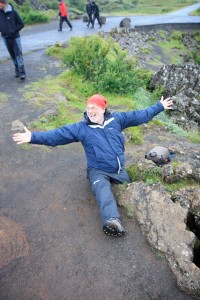 While making our way back to the bus we looked into a couple of pools of extremely clear water. Many visitors had thrown coins into the water and they glistened on the bottom of the pool despite being, perhaps beneath fifteen feet of water. Around the edges of the pool were cracks in the lava caused by the tearing apart of the plates. They were not wide cracks but they were quite deep. Taking care to avoid stepping into a crack I placed my left foot on some grass in the belief that I was placing it on firm ground. My foot and my left leg disappeared until my backside prevented it from sinking further. Thankfully, it was only my pride that was hurt, but it was very funny.
While making our way back to the bus we looked into a couple of pools of extremely clear water. Many visitors had thrown coins into the water and they glistened on the bottom of the pool despite being, perhaps beneath fifteen feet of water. Around the edges of the pool were cracks in the lava caused by the tearing apart of the plates. They were not wide cracks but they were quite deep. Taking care to avoid stepping into a crack I placed my left foot on some grass in the belief that I was placing it on firm ground. My foot and my left leg disappeared until my backside prevented it from sinking further. Thankfully, it was only my pride that was hurt, but it was very funny.
The next day, before we could do anything, we had an early morning appointment with the King’s students to give them their GCSE results. There was a air of nervous apprehension as they received a piece of paper with their results. Having received them they took themselves off to a quiet spot to digest before sharing with each other and, finally, contacting their parents with the news. Thankfully, everybody was happy with their achievements and it meant they could enjoy the rest of the trip. Congratulations to all.
Our third day in the Golden Circle area took us first to experience a glacier walk on Solheimajokull Glacier, a tongue of glacial ice flowing south from the Myrdalsjokull icecap. Meeting with our glacier guide we were fitted with crampons before heading across the moraines towards the snout of the glacier. This activity was kept fairly simple because of the nature of the group but it gave an insight into travelling on a glacier. Each step the teeth of the crampons bit into the ice giving the NCW students an audible impression of their activity and confidence walking on the ice. We did not stray far from the snout as above, although accessible, it was a jumble of ice towers and crevasses as the ice tumbled steeply towards its end. Its surface was crisscrossed with crevasses and water channels, channels of extremely pure water, which we filled our water bottles with.
On the journey to the glacier we had travelled east along the coastal plain with the wall of mountains on our left. Occasionally we had seen mist rising or flashes of white water from the numerous waterfalls that tumbled from the mountains to the coastal plain. Having enjoyed the glacier experience we now retraced our route with the intention of having a closer look at two of these falls. Whilst not as big as Gullfoss in terms of volume, they are dramatically spectacular as they tumble 60m to their plunge pools below.
The first fall was Skogarfoss, a wall of water that falls cleanly over a lip and drops vertically to the pool below. Get too close and the spray gives you a good soaking. When the sun comes out a rainbow arcs across the face of the fall but with gloomy skies above the sun struggles to make an appearance and when it does the moment is short-lived. A path up the side of the fall takes you to vantage points to gain different perspectives of this stunning waterfall. The constant spray and moisture in the air means that the plants around the fall are lush and very green.
Like many of the spectacular sights of south-west Iceland, Skogarfoss is a popular destination for tourists and you have to be prepared to share the experience with others, particularly during the short summer season when tourists flock to Iceland.
Continuing west along the coast road we were travelling through farmland with largely arable fields of grazing cattle. The wall of mountains rose sharply out of the farmland. In the shadow of this wall was a prosperous looking farm. However, the wall holds a sinister threat as it forms the southern flanks of Eyjaflallajokull, the unpronounceable volcano that brought the world’s airlines to a standstill in 2010. The farm was seriously affected by the eruption but instead of cutting and running they have capitalised on the event by opening an Eyjaflallajokull Erupts exhibition showing a film of the eruption and how it affected, not only the farm, but the surrounding area. The film of the eruption is incredible; how people can think of filming in such circumstances, but it makes you want to see the dramatic natural event for yourself.
The second waterfall, Seljalandsfoss, has less volume to it but is none the less spectacular. It seems to be much more vulnerable to the wind, partly because it is in a more exposed position but also because the cliff behind is deeply undercut, allowing the wind to get behind and force the water even further out from the rock. a path passes all the way round the back allowing you to experience the fall from every angle. Again, the vegetation surrounding the waterfall was lush and extremely vivid.
The next day was a travelling day to Landmannalaugar, the start point for our trek. We had a leisurely start to the day as there was no need to rush. The weather held little promise for the day and it was destined to get worse as the it wore on. The route took us into some fairly inhospitable volcanic desert where little or nothing grew. Oskar had plans to take us to a lush little oasis among it for lunch, a green and pleasant valley fed by several waterfalls tumbling from the barren land above.
Continuing after lunch across ever more inhospitable territory the weather took a serious turn for the worse with heavy rain driven by a vicious wind. We stopped at a crater lake and , despite the fact that it was surrounded by high volcanic walls, the wind still managed to whip sheets of water from the surface. We received news from our crew, already at Landmannalaugar, that the wind was too strong to even attempt to pitch tents. By the time we reached the camp the weather was evil. As we sat in the bus contemplating what to do a tent flew past the front of the bus with its owner frantically chasing it across the rocks. The prospect of camping seemed impossible in the circumstances and the huts nearby were overcrowded. The rescue services had refused to allow groups to set out on the trek so new arrivals had nowhere to stay. The toilet block was full of people making a makeshift home, cooking, drying kit and catching up on lost sleep. There was no way we were going to be able to stay here.
A couple of phone calls from Oskar and we were heading back down over the volcanic desert to a cabin at the foot of Mt. Hekla, Iceland’s most active volcano on a regular basis. The weather wasn’t much better hear, 500m lower. The cabins were very well equipped and comfortable. There were two rows of bunks so we put all the NCW students on the bottom and the King’s students on the top level. It was a little cramped but they all coped very well.
The following morning the weather was no better and, if anything, the wind was stronger, suggesting that life up at Landmannalaugar would be very difficult. In fact we soon learned that there had been a fresh fall of snow above Landmannalaugar, which would have made the going significantly more difficult and camping higher up even more unpleasant. Taking advice from Oskar we drove round to Alftavatn, the half way point of our trek. Here we were able to stay in a cabin rather than camp, making the experience not only more pleasant, if not a little crowded, but also a lot more sociable. The route to Alftavatn took us through some stunning scenery. The darkness of the lava was contrasted with vivid green brush strokes of colour from the moss that seems to grow so well while all other plants fail.
Alftavatn is a lone hut just set back from the shore of Lake Alftavatn with super views of green peaks down the valley. It is in a perfect position. The huts are very well supplied and our cabin could cater for all twenty seven of us. It was a bit crowded with all our kitbags but it was ideal for our needs. It was a remarkable sight when a local service bus pulled in to collect passengers. The nearest tarmac road is many miles away but they manage to maintain a twice daily bus service.
After some lunch, and during some respite in the weather, we decided to climb a small peak overlooking the lake. It was a steady climb up through some really dramatic volcanic rock formations to a summit that gave us a stunning 360 degree view. To the north we could see where we should have walked with fresh snow covering the higher slopes. To the south we could see virtually the whole of the next days’s walk. It was good to be walking at last and the students seemed to appreciate it. Although we had had a super time and seen so many dramatic scenes, we had spent quite a bit of time travelling in a coach.
Later in the afternoon I took myself off for a walk along the lake shore. The sky was moody. In the black sand by the lake there was brief evidence of wildlife, fox footprints and wading birds. No sign of the animals themselves.
The following morning we set out on our now shortened trek walking the 16km from Alftavatn to Emstrur. It involved a couple of river crossings and took us through a variety of scenery. Much of the time we were flanked by steep, mossy, green slopes of interesting conical peaks while we were walking on black lava. The walking was easy with few obstacles, allowing progress to be made at a reasonable pace. Whenever we met other trekkers, once they realised the nature of our group, they often stood back in awe. Sometimes, as I stood away from the group to film them, it gave me a different perspective of the trek and I found myself standing in awe of the work the King’s students were doing and the positive attitude and approach of the NCW students.
At Emstrur, as the temperature dropped, we had to decide whether to camp or spread ourselves out between two huts. For simplicity sake we chose the huts. Emstrur is in a stunning position. Its immediate vicinity is a mixture of green moss on a volcanic slag heap. At the head of the valley is a tongue of ice from the Myrdalsjokull icecap. The river, rushing from the snout, cuts its way through the Markarfjlotsgljufur Canyon. Beyond, to the south is the Eyjafjallajokull icecap. If only it wasn’t shrouded in cloud.
The journey from Emstrur to Porsmork is longer (19km) and also involves a lot more up and down. Add to that that we were subjected to a mixture of sunshine and showers, we were expecting a more challenging day. So it proved to be but it was also an incredibly enjoyable day. There were no actual river crossings but there were plenty of water courses to cross. These, with blind and visually impaired people always take a lot longer than normal but it is remarkable how they cope with these obstacles.
None of the mountains around us are particularly high but they all have interesting shapes. For most of the day we had views of a peak called Unicorn Peak. We had some debate as to whether is should be called Rhino Peak or Scarab Beetle Peak. I’ll let you decide which name suits it best.
Towards the end of the walk there was a significant change to the landscape through which we were walking. We were walking through a forest of dwarf birch trees. The moisture from a recent shower glistened in the sunshine giving the impression that each leaf was covered in jewels. Now the ground covering between the trees was grass. We had left the moss behind.
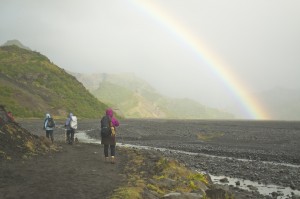 As we dropped into the Porsmork valley and walked along the wide river bed another sharp shower was followed by a spell of sunshine casting a rainbow across the valley rising from somewhere near our campsite. Sadly no pot of gold when we got there. Just before we reached camp we had one last obstacle to overcome, another river. Rather than de-boot every effort was made to help everybody across abd while there were some stumbles most managed to keep their feet dry.
As we dropped into the Porsmork valley and walked along the wide river bed another sharp shower was followed by a spell of sunshine casting a rainbow across the valley rising from somewhere near our campsite. Sadly no pot of gold when we got there. Just before we reached camp we had one last obstacle to overcome, another river. Rather than de-boot every effort was made to help everybody across abd while there were some stumbles most managed to keep their feet dry.
At Porsmork we camped. The campsite was grassy and the dwarf birch trees provided protection from the wind. It was good to be camping and gave the students a fresh experience and a new set of challenges. It wasn’t all hardship as we had an ample structure to socialise and eat in.
We had now arrived at Porsmork a day early so we decided to use the spare day to climb up to the sight of the eruption on Eyjafjallajokull. There were some potentially difficult sections to this walk so we allowed it to be optional. Luckily those whom we had most concern for chose not to come. Again, some of the NCW students showed their determination to take every opportunity presented. The weather was reasonable.
It was a beautiful walk through trees on the lower slopes, circumnavigating a rocky outcrop a little higher with a serious drop on one side. This became a serious drop on both sides as we crossed a narrow ridge. Perhaps, not surprisingly, the blind students showed little concern for the exposure around them. Their guides were a little more anxious but did a fantastic job.
There was some awesome scenery, stunning valleys showing layer upon layer of lava, creating a volcanic timeline, lava arches and towers. Climbing up to a plateau we approach the last climb to our goal. As we did so the weather took a serious turn for the worst. With just 240 vertical metres to climb to the summit with another tricky section to reach it, we decided to turn back. Before we did so, and before the cloud engulfed all before us we were able to look upon some of the recent volcanic activity, with some still smoking.
Returning to camp via the same route we enjoyed a superb BBQ with six legs of lamb cooked to perfection.
The following day, after some delay because Arnie’s coach broke down, we returned to Reykjavik for our last two nights.
On our last full day in Reykjavik we had arranged to visit the Town Hall. There is on display a large three dimensional relief map of Iceland. Normally people cannot touch it but we had sought permission to take the group to see it and for the blind students to be able to feel its shape and texture. Julius, a government official met us and talked to the group about the various landscapes that make up Iceland. (Everybody in Iceland, including the Prime Minister, is always referred to by their first name.) We were made to feel very welcome.
Leaving the Town Hall we visited the cathedral. It is unique as far as cathedrals are concerned, being made entirely of concrete. The tower is made up of a series of increasingly high pillars of concrete. Inside it is the least fussy church I have ever been in. The internal walls and pillars are all of concrete with no decoration. There is a massive organ with 5725 pipes. Sadly we weren’t given the pleasure of hearing it play.
The opportunity to go up the tower to look over Reykjavik had to be taken. Unlike most other cathedrals I have visited, it was not a matter of climbing dozens of steps up a narrow spiral staircase but a short, speedy lift journey to the top of the tower. Had it been a clear day there would have been a fantastic view of distant mountain ranges and icecaps. However, it was not a clear day and the view was much more immediate, the colourful roofs of the buildings below.
The rest of the day was spent enjoying a relaxed lunch (I had a whale steak) and shopping.
Before returning to England we had one more experience to enjoy. En route to the airport we called in at the Blue Lagoon, a power station that has made good use of its facilities to create a hot bathing area, mud treatments, steam rooms and much, much more. The general temperature of the water is 38C, with some parts significantly hotter. In the pool a bar serves drinks of all varieties. It was a great way to end our time in Iceland and it was particularly enjoyable for the NCW students who could compensate for the loss of sight with their other, more astute senses.
This was my first trip to Iceland but it certainly won’t be my last. We were so well looked after by Oskar and his team who made this such a memorable trip. I am extremely grateful to them all. This year Iceland has had its wettest summer on record. Certainly, the weather did its best to spoil our experience, but it failed, miserably. I plan to return next year and see more of this fantastic country. Maybe next year she will help me achieve my ambition to witness a full-blown dramatic eruption.

